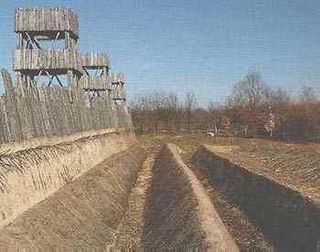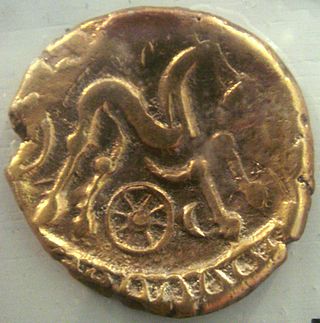
Vercingetorix was a Gallic king and chieftain of the Arverni tribe who united the Gauls in a failed revolt against Roman forces during the last phase of Julius Caesar's Gallic Wars. Despite having willingly surrendered to Caesar, he was executed in Rome.

This article concerns the period 59 BC – 50 BC.

The Gallic Wars were waged between 58 and 50 BC by the Roman general Julius Caesar against the peoples of Gaul. Gallic, Germanic, and British tribes fought to defend their homelands against an aggressive Roman campaign. The Wars culminated in the decisive Battle of Alesia in 52 BC, in which a complete Roman victory resulted in the expansion of the Roman Republic over the whole of Gaul. Though the Gallic military was as strong as the Romans, the Gallic tribes' internal divisions eased victory for Caesar. Gallic chieftain Vercingetorix's attempt to unite the Gauls under a single banner came too late. Caesar portrayed the invasion as being a preemptive and defensive action, but historians agree that he fought the Wars primarily to boost his political career and to pay off his debts. Still, Gaul was of significant military importance to the Romans. Native tribes in the region, both Gallic and Germanic, had attacked Rome several times. Conquering Gaul allowed Rome to secure the natural border of the river Rhine.

The Nervii were one of the most powerful Belgic tribes of northern Gaul at the time of its conquest by Rome. Their territory corresponds to the central part of modern Belgium, including Brussels, and stretched southwards into French Hainault. During their first century BC Roman military campaign, Julius Caesar's contacts among the Remi stated that the Nervii were the most warlike of the Belgae. In times of war, they were known to trek long distances to take part in battles. Being one of the northerly Belgic tribes, with the Menapii to the west, and the Eburones to their east, they were considered by Caesar to be relatively uncorrupted by civilization. According to Tacitus they claimed Germanic descent. According to Strabo they were of Germanic origin.

The Battle of Alesia or Siege of Alesia was the climactic military engagement of the Gallic Wars, fought around the Gallic oppidum of Alesia in modern France, a major centre of the Mandubii tribe. It was fought by the Roman army of Julius Caesar against a confederation of Gallic tribes united under the leadership of Vercingetorix of the Arverni. It was the last major engagement between Gauls and Romans, and is considered one of Caesar's greatest military achievements and a classic example of siege warfare and investment; the Roman army built dual lines of fortifications – an inner wall to keep the besieged Gauls in, and an outer wall to keep the Gallic relief force out. The Battle of Alesia marked the end of Gallic independence in the modern day territory of France and Belgium.

The Battle of the Sabis, also known as the Battle of the Sambre or the Battle against the Nervians, was fought in 57 BC near modern Saulzoir in Northern France, between Caesar's legions and an association of Belgae tribes, principally the Nervii. Julius Caesar, commanding the Roman forces, was surprised and nearly defeated. According to Caesar's report, a combination of determined defence, skilled generalship, and the timely arrival of reinforcements allowed the Romans to turn a strategic defeat into a tactical victory. Few primary sources describe the battle in detail, with most information coming from Caesar's own report on the battle from his book, Commentarii de Bello Gallico. Little is therefore known about the Nervii perspective on the battle.
The Atrebates were a Belgic tribe of the Iron Age and the Roman period, originally dwelling in the Artois region.

The Cantiaci or Cantii were an Iron Age Celtic people living in Britain before the Roman conquest, and gave their name to a civitas of Roman Britain. They lived in the area now called Kent, in south-eastern England. Their capital was Durovernum Cantiacorum, now Canterbury.

The Belgae were a large confederation of tribes living in northern Gaul, between the English Channel, the west bank of the Rhine, and the northern bank of the river Seine, from at least the third century BC. They were discussed in depth by Julius Caesar in his account of his wars in Gaul. Some peoples in southern Britain were also called Belgae and had apparently moved from the continent. T. F. O'Rahilly believed that some had moved further west and he equated them with the Fir Bolg in Ireland. The Roman province of Gallia Belgica was named after the continental Belgae. The term continued to be used in the region until the present day and is reflected in the name of the modern country of Belgium.

The Bellovaci were a Belgic tribe dwelling in the modern Picardy region, near the present-day city of Beauvais, during the Iron Age and the Roman period. After they were defeated by Caesar in 57 BC, they gave lukewarm support to the Gallic revolt led by Vercingetorix in 52 BC. The Bellovaci nonetheless organized resistance against Rome in 51 BC.

Tincomarus was a king of the Iron Age Belgic tribe of the Atrebates who lived in southern central Britain shortly before the Roman invasion. His name was previously reconstructed as Tincommius, based on abbreviated coin legends and a damaged mention in Augustus's Res Gestae, but since 1996 coins have been discovered which give his full name.
Gaius Volusenus Quadratus was a distinguished military officer of the Roman Republic. He served under Julius Caesar for ten years, during the Gallic Wars and the civil war of the 40s. Caesar praised him for his strategic sense and courageous integrity.
Eppillus was the name of a Roman client king of the Atrebates tribe of the British Iron Age. He appears to have ruled part of the territory that had previously been held by Commius, the Gaulish former ally of Julius Caesar who fled to Britain following the uprising of Vercingetorix, or possibly of his son. Eppillus is not mentioned in any historical sources. Coins bearing his name also bear the inscription COMMI.FILI which is generally read as Commios filius indicating at least a claim to be Commius's son.

The Morini were a Belgic coastal tribe dwelling in the modern Pas de Calais region, around present-day Boulogne-sur-Mer, during the Iron Age and the Roman period.

In the course of his Gallic Wars, Julius Caesar invaded Britain twice: in 55 and 54 BC. On the first occasion Caesar took with him only two legions, and achieved little beyond a landing on the coast of Kent. The second invasion consisted of 628 ships, five legions and 2,000 cavalry. The force was so imposing that the Britons did not dare contest Caesar's landing in Kent, waiting instead until he began to move inland. Caesar eventually penetrated into Middlesex and crossed the Thames, forcing the British warlord Cassivellaunus to surrender as a tributary to Rome and setting up Mandubracius of the Trinovantes as client king.
Vercassivellaunus was a Gaulish commander of the Arverni who led a relief force to assist Vercingetorix, who was besieged and low on supplies, in the Battle of Alesia. Caesar refers to him as a cousin of Vercingetorix. He encamped with his generals to the west of the battle. According to Caesar, their names were Commius, Viridomarus and Eporedorix. Sedullos, chief of the Lemovices, joined Vercassivellaunus with 10,000 of his own men and was killed at the battle. According to Caesar's "Commentarii de Bello Gallico", Vercassivellaunus was taken prisoner. It is speculated that he was subsequently strangled to death with the other Gaulish prisoners of war as part of the Triumph in which Caesar celebrated his victory over the Gauls.

The Ambiani were a Belgic coastal tribe dwelling in the modern Picardy region during the Iron Age and Roman periods.

The Battle of Lutetia was a battle on the plain of Grenelle in what is now Paris between Roman forces under Titus Labienus and an anti-Roman Gallic coalition in 52 BC during the Gallic Wars. It was a Roman victory.

Galba was a king (rex) of the Suessiones, a Celtic polity of Belgic Gaul, during the Gallic Wars. When Julius Caesar entered the part of Gaul that was still independent of Roman rule in 58 BC, a number of Belgic polities formed a defensive alliance and acclaimed Galba commander-in-chief. Caesar recognizes Galba for his sense of justice (iustitia) and intelligence (prudentia).

The Celtic currency of Britain were the various items and coins used as currency between approximately 200 BC and AD 60. The earliest currency consisted of various forms of iron bars. Coins were first imported in large numbers in around 150 BC and domestic minting began around 100BC. Coin production was largely ended by the Roman conquest of Britain, first by the Claudian invasion of AD 43 and later by the Defeat of Boudica in AD 60 or 61. Cast coins may have been produced for a few more years around Hengistbury Head. Exact dating of coins often changes in the light of new research.














